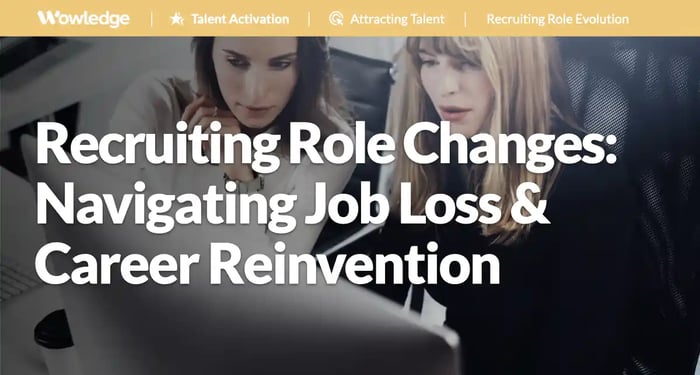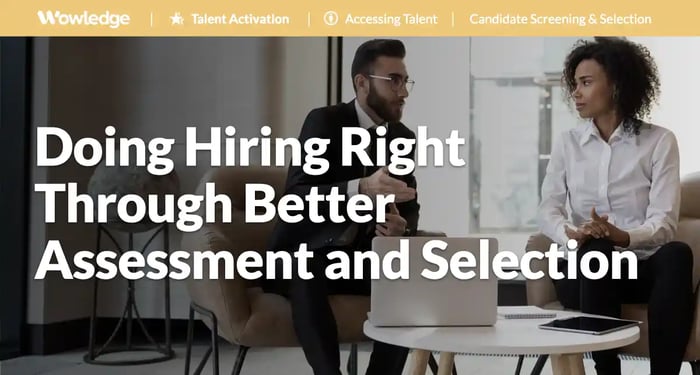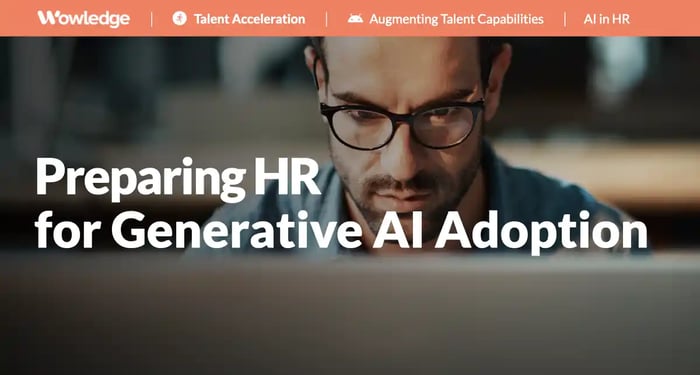Table of Contents
Much has been written about significant shifts in global labor markets, with talent shortages, heightened competition for digital and analytic skills across industries, employee turnover, and external mobility. Equal attention is being paid to ground-shaking shifts due to the seemingly rapid adoption of advanced technologies such as machine learning and artificial intelligence, which are trumpeted as threatening traditional work and jobs. At the same time, while reports of large-scale layoffs have continued, the significant post-pandemic reductions of recruiting or talent acquisition teams have seemingly quieted down. However, the issue is that those jobs have not returned, signaling a need to prepare for enterprise recruiting role changes.
The realities facing recruiting teams
Despite the lack of press coverage that post-pandemic recruiting reductions in force received, several pressures have depressed the hiring of recruiting staffers. At that time, companies downsized by 50% the number of technology recruiters and a range of other HR roles. The reasons? Substantial corporate-wide reductions in force and the elimination of DE&I programs were reported by companies as the primary drivers of these changes. Thousands of full-time and contract recruiters were laid off over a 12-to 36-month period, flooding the market with previously valued and highly skilled talent.
Economic conditions have also significantly contributed to the issue, with hiring demand dropping due to U.S. trade policies and ensuing financial market volatility. As a result, many commercial companies are taking a more conservative approach to staffing and hiring plans. Workday reported that job application volumes grew four times (4X) faster than hiring demand, with the level of new job offers remaining flat year-over-year.
With the rapid expansion and availability of social media and intelligent automated recruiting technologies, employers continue to look for more efficient ways to locate and screen candidates for open positions. This places enormous pressure on recruiting teams' staffing levels and skill requirements.
Adding fuel to this fire, the recruiting function, which every manager and leader has ongoing exposure and experience with, is increasingly seen as a burdensome and tactical provider of suitable candidates for their open jobs. For example, CEOs report that hiring activity is the 3rd most “bureaucratic” process that they encounter in their regular work. Furthermore, only 32% of recruiting leaders are included in strategic planning activities such as corporate workforce planning. Budget and staff cuts become easier when any part of an HR function is perceived primarily as a cost center. These forces are driving a need for recruiting role changes.

Technology is increasingly replacing recruiting tasks
Recruiting, staffing, or talent acquisition (TA) technologies are progressing rapidly, driving recruiting role changes. Some are widely available, while others are emerging and attracting much attention. They are primed to bring remarkable efficiencies and targeting capabilities. This marks a shift from the years of submitting ad content to local or national newspapers and career sites, physically reviewing hard-copy resumes, sending them to managers for review, and calling those they are interested in for screening and interview scheduling by recruiting assistants. Every phase of the traditional recruiting process is being automated, signaling a clear move toward the future of recruiting and talent access. Some of these capabilities are available in specialized systems, while some are integrated into broader recruiting, talent management, or HR platforms. For example:
- AI-enabled platforms use talent intelligence, corporate hiring trends, and internal data to allocate and optimize job posting expenditures across leading job sites.
- Applicant tracking systems (ATS) auto-post jobs, review and rank candidates for a match against job or skill requirements, while enhancing the ability to manage and communicate candidates’ status throughout the process.
- Sourcing technologies now “crawl” and “scrape” the internet for candidates on an automated basis, while screening them for suitability against job requirements.
- Candidate relationship management (CRM) platforms allow interactive engagement with passive and intrigued (but not yet ready to jump) candidates to build relationships designed to convert them over time into interested candidates while continuing the nurturing throughout the process.
- Candidate screening applications use AI to automate the screening process to determine candidates’ suitability for a specific role. They match insights from candidate resumes, LinkedIn profiles, and other submitted (or internet-scraped) content to job requirements.
- Formal assessments can be integrated into candidate management technologies to assess technical skills, language, personality, cultural fit, and situational judgment. More objectivity can be brought into the process, adding credibility and surety to selection decisions.
- Interviewing software can automate scheduling, offer asynchronous video screening interviews, and leverage AI to review candidate responses, body language, and eye movements to score and rank them on a range of suitability criteria. They can also support synchronous video interviewing, eliminating the need for travel or commuting to a job site for initial manager or group interviews.
- Reference checking software auto-generates emails to the candidate’s professional references, which yield higher response rates due to their ease and perceived privacy of response.
- Onboarding platforms engage new hires and prepare them upon offer acceptance to complete required paperwork, enroll in payroll and benefits, get assigned equipment and office space, meet colleagues, get used to the physical environment, and start the enculturation process.
Consider how many of the recruiters' and TA assistants' traditional tasks are now being automated to be done more efficiently, flexibly, and with fewer delays. Think about how appealing that sounds to the CEO, CHRO, and CFO when considering cost and effort levels, and job candidates who complain about long lead times, lack of response to their applications, and the time required to conduct in-person interviews that might be unsuccessful. These are starting to drive recruiting role changes, which will only become more drastic over the coming years.
Reality check on available technologies
Many technological advances that providers promote must be viewed with a critical eye or a healthy dose of skepticism before adoption. Remember that they sell a product or service in a highly competitive market. Talent acquisition and HR technology companies are working to bring the latest capabilities to their platforms and services to a wide range of companies with an even wider range of needs, adoption capabilities, and capacities. While dramatic recruiting role changes feel like an imminent risk, the reality is that a more gradual shift is coming. In other words, one must consider the maturity and sophistication of the individual organization’s:
- Capacity, integrity, and level of integration across existing systems, IT and HRIS infrastructure, and data repository design, space, and capacity.
- IT and HR staffing, expertise, and capacity to implement, integrate, and support newly added platforms.
- Readiness to adopt and configure new HR technologies to meet its mission, culture, and people management processes and practices.
Another key consideration is how prepared the organization is to adopt AI technologies for candidate screening, job matching, and selection decisions. LinkedIn research had found that organizational readiness is not a given, with surveyed companies reporting varying levels of adoption:
- Integrating AI (11% of surveyed companies)
- Experimenting (26%)
- Exploring (31%)
- Not using (32%)
Furthermore, industry analysts report that some vendor claims of AI integration are incomplete, with use cases limited to those they have developed. That translates into challenges when integrating those across existing systems and IT infrastructures and configuring those advanced capabilities to an organization’s specific needs and desired applications.
Even more so is the need for any AI algorithm(s) to learn from the organization’s prior experiences. This means large data sets of HR and talent-related actions and transactions, employee demographics (education, job experience, skills, competencies), performance assessments, and learning and certification histories. These often reside in many HR and talent systems that may or may not be integrated, cleansed, and validated for reliability and accuracy. Relying upon AI technologies when making recruiting role changes should be cautiously approached.

Reinventing recruiting roles: embrace the new, upskill the best
Recruiting role changes involve moving beyond traditional job postings, passive applicant management, and tracking. They encompass what leading recruiters and TA leaders are already doing as strategic professionals: engaging in active consultation with line leaders and managers, proactively assessing future needs, and leveraging technology to more efficiently attract, locate, evaluate, and support hiring decision-making.
What needs to change is the greater embrace of data-driven strategies, understanding how to leverage the latest technological advances to enhance desired hiring outcomes, and building relationships with candidates and hiring managers to attract top talent and improve the overall hiring process. That requires a strategic approach and disciplined change management in an evolutionary manner, considering what technologies are, how they will be engaged, how the recruiting workflow and processes will be best reengineered, and how that work will be collaboratively accomplished between humans and machines.
These transformations can serve as career development and future employee selection or deployment options for individuals with the right skills, aptitudes, and aspirations. The compensation team should be engaged in planning and designing these roles as requirements evolve in synch with process change and advanced technology adoption, forcing recruiting role changes.
1. Broaden the lens: become talent strategists
Rewrite the recruiter's job description to consider staffing requirements beyond external candidates and hires. Start by engaging them in formal, structured, continuous workforce planning efforts at the department, function, business unit, or enterprise level. Have them trained and responsible for working with leaders and managers on identifying how automation and AI adoption will impact roles and what new skills are emerging that can be filled with existing, contracted, or new employees. Assign them to participate in workforce planning efforts as a labor market, sourcing, and skill expert. Engage them in talent planning that balances job requirements with multiple sources of labor—new hires, internal transfers, contractors, and tactics related to targeted upskilling, increased automation, and critical skills retention designed to relieve the pressure on external recruitment.
2. Focus on candidate experience (CX)
Use recruiting team members as strategic job candidate champions, focusing on making the entire pre-hiring (gig or transfer) journey from attraction to screening to selection to decision-making to onboarding experience efficient, pleasant, and welcoming. Develop recruiting staff skills in formal process design and improvement methodologies (e.g., Lean, Six Sigma, Agile), employee listening, and human-centered design to create frictionless and responsive processes. The goal is to have talent acquisition experts create candidate experiences that engage and motivate all candidates to follow through the hiring process and self-select as enthusiastic supporters of the company's values and culture.
3. Evolve into talent, career coaches, and advisors
Recruiters have a unique understanding and expertise in job and career opportunities within their organizations. Think about the time they spend with hiring managers, getting to know the content of jobs and tasks to be accomplished, the requirements, performance expectations, and preferences that hiring managers hold. Consider how intimately recruiters see how the process operates and the reasons why candidates become favored or disfavored. They must know the company’s values and culture and what represents a minimum or ideal candidate fit. Those with tenure have likely supported hiring across several functions, businesses, and roles. They can see the “big picture” about what the organization values and prefers to see in those filling open roles.
These make them ideal guides for external and internal candidates. They can use their skill and aspiration assessment capabilities to inform career choices, help guide internal mobility, and manage project assignments. They can support managers in identifying appropriate learning programs and experiential development opportunities for their staff. They can similarly be used to match independent contractors or “gig workers” with skills gaps on a project basis. Develop recruiting teams' coaching skills, employee learning and development planning knowledge, and resource awareness to support this shift.
4. Develop stronger analytics use and understanding
The more recruiters’ work integrates across talent strategies, the more advanced analytics can be used to identify trends, employee motivations and behaviors, performance differentiators, skills requirements, and overlaps or potential matches. Skills in statistics and data science can be developed to build intelligent models and insights into what makes a highly successful job holder, future subject matter expert, or leader. Have them leverage data analysis to develop their understanding of the factors that define quality of hire for critical roles across the enterprise. And have these experts create or expand talent intelligence capabilities that continuously generate insights into where pockets of needed talent pools live and work as requirements continue or emerge. Engage them in working with the business to assess location strategies, and then identify fertile training grounds (schools, communities) for potential recruitment and apprenticeship relationship building.
5. Learn to work with and accept help from AI co-workers
As technologies advance and adoption levels increase, recruiting role changes will naturally follow. Take a strategic change management approach to the gradual evolution of the roles to shift towards guiding AI to support more efficient and objectively impactful decision-making. Start upskilling recruiting team members on generative AI's basic and more reliable capabilities for composing job postings, candidate outreach, and status/relationship management communications. Create comfort and expertise in building content and messaging for automated “bots” that can provide feedback, guidance, and answers to candidates. Train and develop staffers to work with, validate, quality check, and exercise judgment on actions and decision recommendations that “Agentic AI” tools generate as those “colleagues” or co-workers become more commonly used.
6. Continue to leverage the human element in recruiting
Automation, robotization, and Agentic AI may represent the future of talent acquisition, but recruiting role changes will most certainly not exclude that “human touch” that people still crave and insist upon. Consider how people react to calling “trees” when contacting customer service and support centers and phone lines. When they work well, they are often greeted with appreciation, but when the system cannot understand a question as intended, or provide the answers or actions the caller inquires about, the resulting frustration levels are often substantial.
Humans do better than machines at connecting personally, demonstrating empathy, and exercising judgment based on their knowledge depth and years of experience. Recruiting role changes will not diminish the need and power of being a trusted advisor to hiring managers, an expert guide to job aspirants, a brand ambassador promoting tailored messaging about opportunities to passive candidates, and a source of unique insights into labor markets, candidate preferences, and hiring managers needs based on data and regular ongoing conversations and dialog.
Relevant Practices & Tools
Advanced Career Development Practices that Create a Culture of Mobility and Expand Employee Career Horizons with Technology. >
Advanced Career Development creates and manages a culture of career mobility by building a structured foundation for comparing jobs with overlapping capability requirements... more »
Futureproofing HR by Anticipating Talent Needs and Market Trends. >
Establishing leading HR processes and capabilities will go a long way to drive success in the digital organization... more »
Managing Talent Pipelines to Enhance Speed and Flexibility. >
Talent pipelines represent a strategic approach to speeding up time-to-hire for the organization, but they require ongoing attention... more »
Developing a Winning Talent Strategy to Identify Key Capabilities and the Most Appropriate Workforce Mix. >
A talent strategy defines the talent needs and associated objectives necessary to meet top business goals. It is both an integral part of the HR strategic plan and a direct informer of the talent management strategy and planning process... more »
The Critical Talent Plan Summary Tool: Generate Estimates for Each Workforce Plan Mitigation Strategy to Manage Future Critical Roles. >
A format for guiding and recording the planning of both employee volumes and strategic actions to be taken to close talent gaps projected to occur in the future population of critical role workers for workforce planning uses... more »
About Wowledge
Wowledge is the implementation-first platform designed for lean HR teams and consultants who need to design and scale strategic HR programs efficiently—without starting from scratch.
Our members gain access to continuously updated best practices, step-by-step guidance, expert-built tools, and customizable templates—all structured to accelerate the development and implementation of key HR programs.
Recognizing that every organization operates at different levels of sophistication, Wowledge’s scalable system of best practices follows a stage-based approach—Core, Advanced, and Emerging—ensuring HR professionals can implement solutions tailored to their organization’s unique needs and goals.
Your Shortcut to Amplifying HR Impact!
Get started for FREE! Learn more.










